I use the Sony A7R V as my main camera for various purposes, including photography, 8K video recording, and high-speed continuous shooting.
The camera comes with a single genuine Sony battery: NP-FZ100, but one battery often proves insufficient for power users. To address this, I purchased several third-party batteries from AliExpress. However, most of them have been disappointing in terms of runtime.
Recently, I purchased a new charger for Sony batteries—the ISDT NP2 Air—which can measure battery capacity during charging. Using this charger, I measured the capacity of all my batteries I have, both genuine Sony and third-party ones.
The measurement process was as follows:
- I discharged each battery to 0%, until the internal protection cut-off was triggered. On most third-party batteries, the BMS cuts off output near 6.2 V (approximately 3.1 V per cell). However, the genuine Sony battery does not cut off even at 6.0 V, making a perfect in-camera discharge impossible. (The camera avoids to boot up with ‘Battery Exhausted’ popup.) Since most lithium-ion batteries show almost zero capacity below about 3.4 V per cell, this discrepancy may not be critical. Note, though, that discharging below 3.0 V can damage lithium-ion cells.
-
Due to their high internal resistance, some batteries never reached 100 percent even after the charger displayed the “Charge Completed” message. I tested both quick charge mode on and off but observed no significant difference. FYI: the ISDT NP2 Air’s quick charge mode for NP-FZ100 batteries supplies 1.5A, whilst normal mode supplies 1.0A; both rate remain well below the 1C charging limit, typical of most Li-Ion batteries. I charged each battery until the charger shut off automatically.
Batteries tested
- Sony NP-FZ100
- Batmax NP-FZ100 (from AliExpress)
- Probty NP-FZ100 (beige model with USB-C charging port; from AliExpress)
- SmallRig 4265 NP-FZ100 (blue model)
Rated Capacities
- Sony NP-FZ100: 2280 mAh
- Batmax NP-FZ100: 2280 mAh
- Probty NP-FZ100: 2800 mAh
- SmallRig 4265 NP-FZ100: 2400 mAh (cell capacity; battery nominal capacity is 2250mAh)
Prices
- Sony NP-FZ100: ~₩75,000
- Batmax NP-FZ100 (two batteries + dual charger): USD 39.69
- Probty NP-FZ100: USD 20.97
- SmallRig 4265 NP-FZ100: USD 34.05
Measured Weights
- Sony NP-FZ100: battery #1 0 82.53 g; battery #2 – 82.44 g
- Batmax NP-FZ100: not measured yet
- Probty NP-FZ100: 79.02 g
- SmallRig 4265 NP-FZ100: 78.30 g
Manufacture Dates
- Sony NP-FZ100: battery #1 – 2022; battery #2 – 2024
- Batmax NP-FZ100: 2022
- Probty NP-FZ100: 2023
- SmallRig 4265 NP-FZ100: 2025
Note: Capacity measurements were performed in June 2025.
Results
- Sony batteries
- Battery #1 (manufactured 2022): 2381 mAh
- Battery #2 (manufactured 2024): 2422 mAh
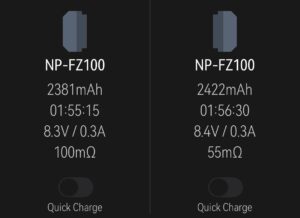
- Batmax batteries
- Battery #1: 1756 mAh
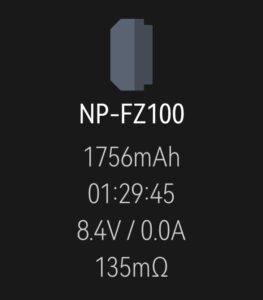
- Battery #2: 1726 mAh
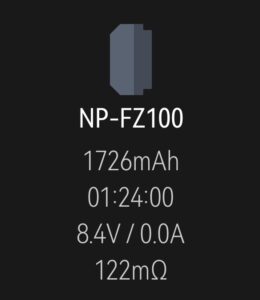
- Battery #1: 1756 mAh
- Probty battery: 1863 mAh
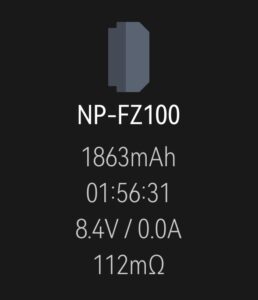
- SmallRig battery: 2417 mAh
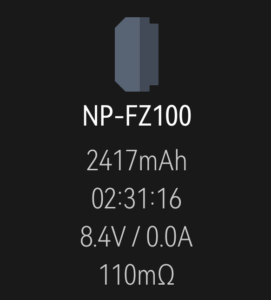
Disclaimer: One Sony battery, as well as the Batmax and Probty batteries, were purchased several years ago and may have undergone significant degradation.
Intrinsic discharge after 30 days on shelf
- Each battery underwent voltage measurements just before being placed into 30 days of storage.
- Three batteries (Sony, SmallRig, and Probty) were stored in a humidity-controlled dry cabinet at an ambient temperature of 25–26°C.
-
The first measurements
The Probty and SmallRig batteries were measured at 8.37 V open circuit, while the Sony battery was measured at 8.36 V.
The test began on June 27th — marking Day 0.
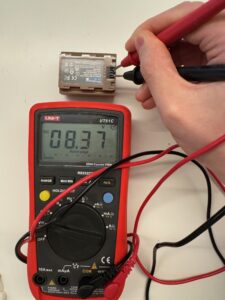
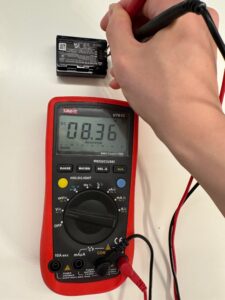
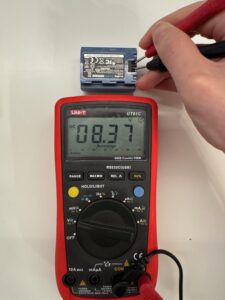
The day 30
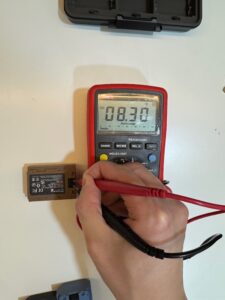


- All batteries were removed from the cabinet and measured on July 27th.
- The open circuit voltage of the Probty battery was 8.30 V, the highest among the three, followed by 8.28 V for the SmallRig and 8.24 V for the Sony.
- However, the in-camera battery percentage display was not consistent with the open circuit voltage: The Probty and SmallRig batteries showed 100%, whereas the Sony battery showed 93%.
Recharge test
- Actual discharged current is measured by topping up each tested subject again to 100%.
- The Probty battery took in 11 mAh.
- The SmallRig battery and Sony battery both have taken 13 mAh to the full charge.
| Battery | Probty | SmallRig | Sony |
|---|---|---|---|
| Rated capacity | 2800mAh | 2400mAh | 2280mAh |
| Measured capacity | 1863mAh | 2417mAh | 2381mAh / 2422mAh |
| Natural discharge over 30 days* | -11mAh | -13mAh | -13mAh |
| Charge displayed in camera after 30 days | 100% | 100% | 93% |
- May contain inaccuracy. Will be updated later.
Update (July 27): Charge Measurement Inaccuracy Observed, due to implementation of trickle charging in ISDT NP2 Air.
- I discovered that the ISDT NP2 Air continues trickle-charging the battery even after the “Charge Completed” message is shown. The actual charge is not displayed during this phase, but the battery percentage (which is just around 97% when ‘charge completed’ message is displayed) increases gradually.
- This behavior means that for batteries with high internal resistance, the measured capacity may reflect only the constant current (CC) phase. As is widely known, Li-ion and Li-Po batteries are charged using a CC-CV method—first charging with constant current as voltage rises, then switching to constant voltage (CV) mode once a threshold is reached (typically near 100% rated voltage). In CV mode, remaining charge is delivered slowly. In most cases, (at least in measurement industries) measuring a small current is a lot more tricky than measuring Ampare-level powers.
- For you not familiar with the charging processes of Li-Ion and Li-Po batteries: most Li-Ion and Li-Po battery goes through CC-CV charging procedure, which first charge the cell in constant current (with voltage slowly ramping up). If the cell voltage became higher than a preset value with CC charging, (usually set near 100% point), The charger itself switches to CV charging mode, which ‘trickle charge’ the leftovers relatively slow.

Therefore, especially for cells with high internal resistance, measured capacity displayed by ISDT NP2 Air charger just reflects CC charging state, which is slightly smaller than their original capacity.
Conclusions
The genuine Sony NP-FZ100 batteries demonstrated exceptional capacity retention after three years of use. In contrast, most third-party NP-FZ100 batteries exhibited significantly lower capacities. Only one third-party model, the SmallRig 4265, exceeded its rated capacity. Although some third-party batteries offer additional features—such as USB-C charging—these come at the expense of usable capacity.
Despite both genuine and aftermarket batteries using the same 18500 (or 18490) standard cells, I remain surprised that no third-party manufacturer offers capacities comparable to Sony’s genuine units.
Limitations
- Accurate capacity measurement requires a dedicated load tester. These measurements were performed by the charger itself, so actual discharge performance and stored energy may differ, especially due to variations in internal resistance. Note: these measurements reflect charge capacity, not energy capacity.
- Only a single sample of each battery model was tested; these samples may be defective or unrepresentative.
I have begun a natural discharge test for all units today (June 29). I will provide updates later.
Discover more from ATIK.KR
Subscribe to get the latest posts sent to your email.